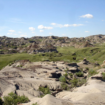Fort trader experience opens view of 19th century life in Alberta
By Ry Clarke - Lethbridge Herald Local Journalism Initiative Reporter on July 22, 2022.
 Herald photo by Ry Clarke
Indigenous coordinator Tanis Crosschild, along with Fort interpreters Matthew Primrose and Sasha McConnell, speak with visitors about the life of early settlers and Blackfoot culture in the 1800's as part of the Life and Labour of a Fort Trader program Thursday at Fort Whoop-Up.
Herald photo by Ry Clarke
Indigenous coordinator Tanis Crosschild, along with Fort interpreters Matthew Primrose and Sasha McConnell, speak with visitors about the life of early settlers and Blackfoot culture in the 1800's as part of the Life and Labour of a Fort Trader program Thursday at Fort Whoop-Up.Fort Whoop-Up held an educational event Thursday morning teaching audiences of the life and labour of a fort trader back in the 1800s.
The extended tour looked at the experience of the time with educational videos, presentations, and activities to showcase the lifestyle back in settler times. Also included was how the Fort interacted with the Indigenous community of the time, welcoming guests to the Blackfoot Gallery where Indigenous Coordinator Assistant, Tanis Crosschild, helped share the culture that many settlers where interacting with at the time. Crosschild’s teachings included territorial maps, interactive displays, and models of the history here in Lethbridge.
The experience showcases the heritage found within in southern Alberta, while keeping members of the audience engaged with plenty of opportunities to learn something new.
Crosschild shared her knowledge to audiences about how Spaniards were the ones to bring horses to the land in the 1600s and how before that they would use wolves to help transport commodities like bed rolls, and building materials.
“We would find a wolf den, and we would wait for the parents to leave the den. We would get a long rosebush tree that had a lot of thorns on it, and we would stick it right into the den and wait. We would kind of wave it around a little bit until it caught on to the wolf-pups fur. And once it did, then lure them out.”
“The Blackfoot people have a very spiritual connection with the wolf,” said Fort attendant Matthew Primrose. “The wolf is one of the original hunters of the buffalo, and that’s how Blackfoot people learned to hunt. So with that being said, anything with a claw is never eaten by the Blackfoot people. That’s why buffalo is a main staple food source for them. Because it’s hoofed.”
Abbilynn Thom, Fort coordinator, says experiences like this are important, sharing an authentic experience with audiences while showcasing what an average day would look like in the past. The research and information is from historic curators at the Galt Museum, and Indigenous experts.
“We know that having both perspectives (is) a more authentic story to put forward to people.”
Fort attendees are also encouraged to research and broaden their topics, making sure the uniqueness of the Fort is one-of-a-kind but true to the past. Thom notes the experience looks to teach the relationships of the traders, a look at daily lifestyles, and how somebody would have truly lived a life in the 1800s.
“We have some activities like candle dipping, making candles from scratch with beeswax, we do quill and ink writing on postcards while talking about how the Postal Service would have happened at Fort Whoop-Up. And also we have a photo booth we set up and people can dress up in period clothes and take pictures.”
With many activities to keep the audience engaged and learning, the experience is a great way to study the history in Lethbridge.
The Life and Labour of a Fort Trader Experience is available every Thursday at 9:30 with registration online at galtmuseum.com/events.
13-12




